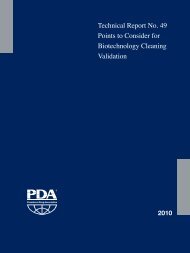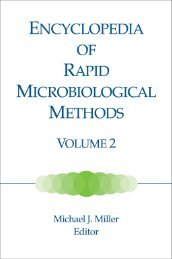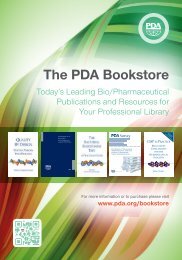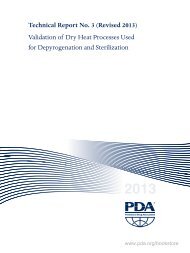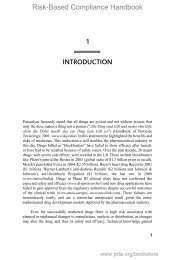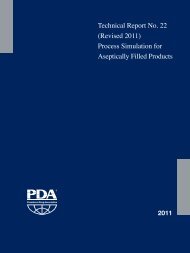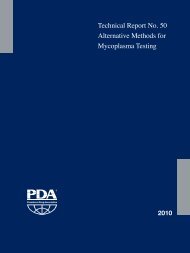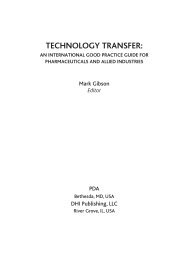Table of Contents - store.pda.org - Parenteral Drug Association
Table of Contents - store.pda.org - Parenteral Drug Association
Table of Contents - store.pda.org - Parenteral Drug Association
Create successful ePaper yourself
Turn your PDF publications into a flip-book with our unique Google optimized e-Paper software.
Technical Report No. 29 (Revised 2012)<br />
Points to Consider for<br />
Cleaning Validation<br />
Paradigm Change in<br />
Manufacturing Operations SM<br />
Bethesda Towers<br />
4350 East West Highway<br />
Suite 200<br />
Bethesda, MD 20814 USA<br />
Tel: 1 (301) 656-5900<br />
www.<strong>pda</strong>.<strong>org</strong>/book<strong>store</strong>
PDA Task Force on Technical Report No. 29 (Revised 2012):<br />
Points to Consider for Cleaning Validation<br />
Authors<br />
Destin A. LeBlanc, Cleaning Validation Technologies<br />
(Chair)<br />
Gretchen Allison, Pfizer<br />
Jennifer L. Carlson, Genentech<br />
Koshy Ge<strong>org</strong>e, Consultant<br />
Igor Gorsky, ConcordiaValSource<br />
Irwin S. Hirsh, Novo Nordisk AS<br />
Jamie Osborne, Siegfried (USA), Inc.<br />
Greg Randall, Baxter Bioscience<br />
Pierre-Michel Riss, Eli Lilly<br />
Ge<strong>org</strong>e Verghese, STERIS Corporation<br />
Jenn Walsh, Bristol-Myers Squibb<br />
Vivienne Yankah, San<strong>of</strong>i-Pasteur, Ltd.<br />
The content and views expressed in this Technical Report are the result <strong>of</strong> a consensus achieved by the authorizing<br />
Task Force and are not necessarily views <strong>of</strong> the <strong>org</strong>anizations they represent.<br />
www.<strong>pda</strong>.<strong>org</strong>/book<strong>store</strong>
Points to Consider for<br />
Cleaning Validation<br />
Technical Report No. 29 (Revised 2012)<br />
ISBN: 978-0-939459-48-3<br />
© 2012 <strong>Parenteral</strong> <strong>Drug</strong> <strong>Association</strong>, Inc.<br />
All rights reserved.<br />
Bethesda Towers<br />
4350 East West Highway<br />
Suite 200<br />
Bethesda, MD 20814 USA<br />
Tel: 1 (301) 656-5900<br />
Fax: 1 (301) 986-0296<br />
E-mail: info@<strong>pda</strong>.<strong>org</strong><br />
Web site: www.<strong>pda</strong>.<strong>org</strong><br />
www.<strong>pda</strong>.<strong>org</strong>/book<strong>store</strong>
Paradigm Change in Manufacturing Operations (PCMO SM )<br />
PDA launched the project activities related to the PCMO program in December 2008 to help implement<br />
the scientific application <strong>of</strong> the ICH Q8, Q9 and Q10 series. The PDA Board <strong>of</strong> Directors approved<br />
this program in cooperation with the Regulatory Affairs and Quality Advisory Board, and the<br />
Biotechnology Advisory Board and Science Advisory Board <strong>of</strong> PDA.<br />
Although there are a number <strong>of</strong> acceptable pathways to address this concept, the PCMO program follows<br />
and covers the drug product lifecycle, employing the strategic theme <strong>of</strong> process robustness within<br />
the framework <strong>of</strong> the manufacturing operations. This project focuses on Pharmaceutical Quality<br />
Systems as an enabler <strong>of</strong> Quality Risk Management and Knowledge Management.<br />
Using the <strong>Parenteral</strong> <strong>Drug</strong> <strong>Association</strong>’s (PDA) membership expertise, the goal <strong>of</strong> the Paradigm<br />
Change in Manufacturing Operations Project is to drive the establishment <strong>of</strong> ‘best practice’ documents<br />
and /or training events in order to assist pharmaceutical manufacturers <strong>of</strong> Investigational<br />
Medicinal Products (IMPs) and commercial products in implementing the ICH guidelines on Pharmaceutical<br />
Development (ICH Q8, Q11), Quality Risk Management (ICH Q9) and Pharmaceutical<br />
Quality Systems (ICH Q10).<br />
The PCMO program facilitates communication among the experts from industry, university and regulators<br />
as well as experts from the respective ICH Expert Working Groups and Implementation Working<br />
Group. PCMO task force members also contribute to PDA conferences and workshops on the subject.<br />
PCMO follows the product lifecycle concept and has the following strategic intent:<br />
• Enable an innovative environment for continual improvement <strong>of</strong> products and systems<br />
• Integrate science and technology into manufacturing practice<br />
• Enhance manufacturing process robustness, risk based decision making and knowledge management<br />
• Foster communication among industry and regulatory authorities<br />
The Product Life Cycle<br />
Pharmaceutical<br />
Development<br />
Technology<br />
Transfer<br />
Commercial<br />
Manufacturing<br />
Product<br />
Discontinuation<br />
For more information, including the PCMO Dossier, and to get involved, go to<br />
www.<strong>pda</strong>.<strong>org</strong>/pcmo<br />
www.<strong>pda</strong>.<strong>org</strong>/book<strong>store</strong>
<strong>Table</strong> <strong>of</strong> <strong>Contents</strong><br />
1.0 Introduction..........................................................1<br />
1.1 Purpose/Scope................................................. 1<br />
2.0 Glossary <strong>of</strong> Terms................................................3<br />
2.1 Definition <strong>of</strong> Acronyms..................................... 5<br />
3.0 Cleaning Process Design and Development........7<br />
3.1 Cleaning Process Design.................................. 7<br />
3.2 Cleaning Process Overview.............................. 8<br />
3.2.1 Physical-chemical Aspects ................. 9<br />
3.3 Design Considerations.................................... 10<br />
3.3.1 Location <strong>of</strong> Cleaning........................... 10<br />
3.3.1.1 In-Place Cleaning........................... 10<br />
3.3.1.1.1 Clean-in-Place (CIP) Systems........ 10<br />
3.3.1.1.2 Solvent Reflux Cleaning................. 11<br />
3.3.1.1.3 Placebo Batches as a<br />
Cleaning Method........................... 11<br />
3.3.1.2 Out-<strong>of</strong>-Place Cleaning.................... 11<br />
3.3.1.2.1 Clean-Out-<strong>of</strong>-Place Systems.......... 12<br />
3.3.2 Automated vs. Manual Systems........ 12<br />
3.3.2.1 Manual Processes......................... 12<br />
3.3.2.2 Semi-Automated Processes.......... 12<br />
3.3.2.3 Automated Processes................... 13<br />
3.3.3 Soil Evaluation and Categorization...... 13<br />
3.3.3.1 Soil Categories.............................. 13<br />
3.3.3.2 Soil Removal................................. 13<br />
3.3.4 Equipment Considerations.................. 14<br />
3.3.4.1 Dedicated – Nondedicated<br />
Manufacturing Equipment............. 14<br />
3.3.4.2 Nonproduct Contact – Product<br />
Contact Surfaces........................... 15<br />
3.3.4.3 Low-Risk Sites – High-Risk Sites.. 15<br />
3.3.4.4 Materials <strong>of</strong> Construction.............. 15<br />
3.3.5 Operational Considerations................. 15<br />
3.3.6 Cleaning Agent Selection................... 16<br />
3.3.7 Product Considerations...................... 16<br />
3.3.7.1 Product Risk Considerations.......... 17<br />
3.4 Cleaning Development<br />
Laboratory Experiments ................................. 17<br />
3.4.1 Soil Selection ..................................... 17<br />
3.4.2 Parameter Selection........................... 18<br />
3.4.2.1 Parameter Interactions ................. 19<br />
3.4.3 Measurements to Determine<br />
Cleaning Effectiveness....................... 19<br />
3.5 Cleaning Process Scale-Up............................. 19<br />
3.5.1 Setting Process Controls.................... 19<br />
3.6 Applying the “Design Space” Concept to<br />
Cleaning Processes ....................................... 20<br />
3.7 Standard Operating Procedures...................... 21<br />
3.8 Operator Training for the Cleaning Process..... 21<br />
3.9 Introduction <strong>of</strong> New Products to a<br />
Validated Cleaning System............................. 22<br />
4.0 Qualification.......................................................23<br />
4.1 Protocol Elements........................................... 23<br />
4.2 Key Protocol Issues ....................................... 23<br />
4.2.1 Number <strong>of</strong> Runs in a Protocol............. 24<br />
4.2.2 Mock Soiling...................................... 24<br />
4.2.3 Worst-Case Process Conditions......... 24<br />
4.2.4 Disposition <strong>of</strong> Products and Equipment<br />
during Validation................................. 25<br />
4.3 Grouping/Family Approach............................. 25<br />
4.3.1 Product Grouping................................ 26<br />
4.3.2 Equipment Grouping........................... 26<br />
4.3.3 Introduction <strong>of</strong> a New Product or<br />
Equipment into a Group...................... 27<br />
4.4 “Cleaning Verification” Documentation........... 27<br />
5.0 Residue and Limits.............................................29<br />
5.1 Considerations for Developing Limits............ 29<br />
5.2 The Basis for Quantitative Limits............. 30<br />
5.3 Acceptable Concentration <strong>of</strong> Residue in<br />
Next Product...................................... 30<br />
5.3.1 ARL Based on <strong>Drug</strong> Active Dose........ 30<br />
5.3.2 ARL Based on Toxicity........................ 31<br />
5.3.2.1 ADE Determinations Based on ISPE’s<br />
Risk-MaPP..................................... 31<br />
5.3.2.2 Toxicity Calculations Based<br />
on LD 50<br />
Data.................................. 32<br />
5.3.3 Other ARL Determinations.................. 33<br />
5.4 Acceptable Total Carryover............................ 33<br />
5.5 Surface Area Limit.......................................... 34<br />
5.6 Limit in Protocol Samples............................... 34<br />
5.6.1 Limit per Swab................................... 34<br />
5.6.2 Concentration Limit in<br />
Extracted Swab Solvent..................... 34<br />
5.6.3 Concentration Limit in<br />
Rinse Sampling Solution..................... 35<br />
5.7 Consolidated Expressions............................... 35<br />
5.8 Example Calculations..................................... 36<br />
5.9 Other Considerations...................................... 36<br />
5.9.1 Multiple Next Products....................... 36<br />
5.9.2 Next Product in Verification<br />
Approach............................................ 37<br />
5.9.3 Default Limits..................................... 37<br />
www.<strong>pda</strong>.<strong>org</strong>/book<strong>store</strong>
5.9.4 Use <strong>of</strong> Different Safety Factors........... 38<br />
5.9.5 Different Routes <strong>of</strong> Administration..... 38<br />
5.9.6 Different Doses for<br />
Adults and Children............................ 38<br />
5.9.7 Human and Veterinary<br />
Products Manufactured on the<br />
Same Equipment................................ 38<br />
5.9.8 Residues <strong>of</strong> Genotoxic and Other Highly<br />
Hazardous Active Ingredients............. 38<br />
5.9.9 Limits Based on Analytical<br />
Detection Limits................................. 39<br />
5.9.10 Degradation <strong>of</strong> the Active Ingredient.. 39<br />
5.9.11 Limits Not Measureable..................... 39<br />
5.9.12 Limits for Organic Solvents................. 39<br />
5.9.13 Dedicated Equipment ........................ 40<br />
5.9.14 Dividing a Limit among Various<br />
Pieces <strong>of</strong> Equipment........................... 40<br />
5.9.15 .Limits for Preferential Transfer to a First<br />
Portion <strong>of</strong> the Next Product................ 40<br />
5.9.16 Limits for Biotechnology<br />
Manufacture....................................... 40<br />
5.9.17 Products with More Than One Active<br />
Ingredient........................................... 41<br />
5.10 Bioburden Limits...................................... 41<br />
5.11 Endotoxin Limits...................................... 42<br />
5.12 Visually Clean Criterion ........................... 42<br />
6.0 Sampling.............................................................43<br />
6.1 Sampling Method Selection........................... 43<br />
6.1.1 Direct Sampling Methods................... 43<br />
6.1.1.1 Visual Inspection........................... 43<br />
6.1.1.2 Instrumental Methods................... 44<br />
6.1.2 Rinse Sampling................................... 44<br />
6.1.2.1 Extraction Rinse Sampling for Small<br />
Parts.............................................. 46<br />
6.1.2.2 Solvent Reflux Sampling................ 46<br />
6.1.3 Swab and Wipe Sampling.................. 46<br />
6.2 Placebo Sampling........................................... 47<br />
6.3 Sampling for Microbial and<br />
Endotoxin Analysis......................................... 47<br />
6.4 Additional Considerations............................... 48<br />
6.5 Sampling Recovery Studies............................ 48<br />
6.5.1 General Considerations....................... 48<br />
6.5.2 Swab/Wipe Recovery......................... 49<br />
6.5.3 Rinse Recovery................................... 50<br />
6.5.4 “Recovery” in Visual Inspection......... 51<br />
6.5.5 Recovery for Bioburden and<br />
Endotoxin Sampling............................ 51<br />
6.6 Training and Qualification <strong>of</strong> Samplers............ 51<br />
6.6.1 Key Issues for Training<br />
for Swab Sampling............................. 52<br />
6.6.2 Key Issues for Training for Rinse<br />
Sampling............................................ 52<br />
6.6.3 Training for Visual Inspection.............. 52<br />
7.0 Analytical Methods............................................54<br />
7.1 Purposes <strong>of</strong> the Analytical Methods............... 54<br />
7.2 Practical Considerations in Selecting Analytical<br />
Methods......................................................... 54<br />
7.3 Specific vs. Nonspecific Analytical Methods for<br />
Validation Protocols........................................ 55<br />
7.3.1 Regulatory Status <strong>of</strong> Specific and<br />
Nonspecific Methods.................... 55<br />
7.4 Most Commonly Used Analytical Techniques.56<br />
7.4.1 Liquid Chromatography (LC)............... 56<br />
7.4.2 UltraViolet/Visible Spectrophotometry<br />
(UV/Vis).............................................. 57<br />
7.4.3 Total Organic Carbon (TOC)................ 57<br />
7.4.4 Conductivity....................................... 57<br />
7.4.5 Organoleptic Evaluation...................... 58<br />
7.5 Other Useful Analytical Techniques................ 59<br />
7.5.1 pH....................................................... 59<br />
7.5.2 InfraRed (IR)....................................... 59<br />
7.5.3 Light Microscopy................................ 59<br />
7.5.4 Titrations............................................ 59<br />
7.5.5 Gravimetric Analysis.......................... 59<br />
7.5.6 Enzyme Linked Immunosorbant<br />
Assay (ELISA).................................... 60<br />
7.5.7 Capillary Zone Electrophoresis (CZE)....60<br />
7.5.8 Atomic Absorption (AA) and<br />
Inductively Coupled Plasma (ICP)....... 60<br />
7.5.9 Ion Mobility Spectrometry (IMS)........ 60<br />
7.6 Microbial Test Methods.................................. 60<br />
7.6.1 Endotoxin........................................... 60<br />
7.6.2 Bioburden........................................... 60<br />
7.7 Analytical Method Validation.......................... 61<br />
7.7.1 General Principles............................... 61<br />
7.7.2 Compendial Methods......................... 62<br />
7.7.3 Visual Inspection................................ 63<br />
7.7.4 Bioburden Methods............................ 63<br />
7.7.5 Transfer to another Laboratory and<br />
Use <strong>of</strong> Contract Laboratories.............. 63<br />
8.0 Maintenance <strong>of</strong> Validated State.........................64<br />
8.1 Critical Parameter Measurement.................... 64<br />
8.2 Process Alarms.............................................. 64<br />
8.3 Change Control............................................... 65<br />
www.<strong>pda</strong>.<strong>org</strong>/book<strong>store</strong>
8.4 Routine Monitoring......................................... 66<br />
8.5 Data Trending and Review.............................. 66<br />
8.6 Evaluation <strong>of</strong> Cumulative Changes.................. 67<br />
8.7 Training........................................................... 67<br />
8.8 Periodic Review.............................................. 67<br />
9.0 Documentation....................................................69<br />
9.1 Cleaning Validation Master Plans................... 69<br />
9.1.1 Elements <strong>of</strong> a Comprehensive Plan..... 70<br />
9.1.2 Harmonization <strong>of</strong> Site Cleaning<br />
Validation Programs ........................... 71<br />
9.2 Documentation for Design/Development........ 71<br />
9.3 Documentation for Qualification..................... 72<br />
9.4 Documentation for Validation Maintenance.... 72<br />
9.5 Other Documentation Considerations............. 73<br />
10.0 Special Considerations.....................................75<br />
10.1 Cleaning Agents...................................... 75<br />
10.1.1 Types.................................................. 75<br />
10.1.1.1 Water.............................................. 75<br />
10.1.1.2 Organic Solvents............................. 75<br />
10.1.1.3 Commodity Alkali............................ 75<br />
10.1.1.4 Commodity Acids........................... 75<br />
10.1.1.5 Formulated Detergents.................... 75<br />
10.1.2 Factors in Selection............................ 76<br />
10.1.2.1 Broad Spectrum Effectiveness........ 76<br />
10.1.2.2 Substrate Compatibility.................. 76<br />
10.1.2.3 Stability and Shelf Life.................... 76<br />
10.1.2.4 Analyzability.................................... 76<br />
10.1.2.5 Disposal.......................................... 76<br />
10.1.2.6 Safety............................................. 76<br />
10.1.2.7 Toxicity........................................... 76<br />
10.1.2.8 Rinsability....................................... 76<br />
10.1.2.9 Quality............................................. 76<br />
10.2 Nonproduct Contact Surfaces.................. 76<br />
10.3 Process Analytical Technology................ 77<br />
10.3.1 Timely Measurements........................ 77<br />
10.3.2 PAT for Cleaning Process Control........ 77<br />
10.3.3 Additional Considerations for Online<br />
Measurements................................... 78<br />
10.4 Clean Hold Considerations....................... 78<br />
10.5 New and Used Equipment....................... 80<br />
10.5.1 New Equipment................................... 80<br />
10.5.1.1 Cleaning Procedure Development... 80<br />
10.5.1.2 Post-Installation Cleaning................ 81<br />
10.5.1.3 Grouping Impact............................... 81<br />
10.5.1.4 Limit Calculation Impact................... 81<br />
10.5.2 Used Equipment................................. 81<br />
10.6 Measurement Systems Analysis (MSA) .81<br />
10.6.1 MSA Components.............................. 82<br />
10.6.2 Attribute R&R..................................... 82<br />
10.6.3 Minimizing Variations......................... 82<br />
10.6.4 MSA and Cleaning<br />
Validation Strategy............................. 82<br />
10.7 Cleaning for API Manufacture.................. 83<br />
10.8 Topical <strong>Drug</strong> Products.............................. 84<br />
10.8.1 Topical <strong>Drug</strong> Products with<br />
Systemic Availability.......................... 84<br />
10.8.2 Topical <strong>Drug</strong> Products with No or<br />
Limited Systemic Availability............. 85<br />
10.8.2.1 Adjusted Calculation....................... 85<br />
10.8.2.2 Modification Based on<br />
Frequency <strong>of</strong> Application................ 85<br />
10.8.2.3 Modification Based on Amount<br />
Applied per Surface Area................ 85<br />
10.8.2.4 Additional Considerations............... 86<br />
10.8.3 Additional Safety Considerations........ 86<br />
10.8.4 Additional Cleaning Considerations.... 86<br />
10.9 Animal <strong>Drug</strong> Products.............................. 86<br />
10.10 Packaging Components and<br />
Packaging Equipment................................ 86<br />
10.10.1 Primary Packaging Components........ 86<br />
10.10.1.1 Oral Dosage Forms Primary<br />
Packaging Components................. 87<br />
10.10.1.2 <strong>Parenteral</strong> Dosage Forms Primary<br />
Packaging Components................. 87<br />
10.10.2 Packaging Equipment........................ 87<br />
10.10.2.1 Primary Packaging Equipment....... 87<br />
10.10.2.2 Secondary Packaging Equipment.. 88<br />
10.11 Tubing and Hoses.................................... 88<br />
10.12 Excipients................................................ 89<br />
10.13 Dedicated Equipment............................... 89<br />
10.13.1 Reasons for Dedication...................... 89<br />
10.13.2 Cleaning Validation Issues................. 90<br />
11.0 Regulatory and Guidance Documents..............91<br />
12.0 References........................................................92<br />
13.0 Suggested Readings.........................................94<br />
www.<strong>pda</strong>.<strong>org</strong>/book<strong>store</strong>
FIGURES AND TABLES INDEX<br />
<strong>Table</strong> 3.1-1 CPP and CQA Considerations that<br />
have Potential Risk Impact to a<br />
Cleaning Process.................................. 7<br />
<strong>Table</strong> 3.1-2 The Cleaning Spectrum........................ 8<br />
<strong>Table</strong> 3.2-1 Cleaning Process Steps (Examples)..... 9<br />
<strong>Table</strong> 6.1.2-1 Comparison <strong>of</strong> Grab Sampling versus<br />
Separate Sampling Rinse.................... 45<br />
<strong>Table</strong> 6.1.2-2 Advantages and Limitations<br />
<strong>of</strong> Rinse Sampling............................... 45<br />
<strong>Table</strong> 6.1.3-1 Advantages and Limitations<br />
<strong>of</strong> Swab/Wipe Sampling..................... 47<br />
Figure 9.5-1 Documentation for Process Flow........ 74<br />
www.<strong>pda</strong>.<strong>org</strong>/book<strong>store</strong>
1.0 Introduction<br />
Cleaning validation plays an important role in reducing the possibility <strong>of</strong> product contamination from<br />
pharmaceutical manufacturing equipment. It demonstrates that the cleaning process adequately and<br />
consistently removes product residues, process residues and environmental contaminants from the<br />
manufacturing equipment/system, so that this equipment/system can be safely used for the manufacture<br />
<strong>of</strong> specified subsequent products (which may be the same or a different product). As used in<br />
this Technical Report, “product” may be a drug product, active pharmaceutical ingredient, intermediate,<br />
or another type <strong>of</strong> formulation. If “drug product” is intended, that terminology will be utilized.<br />
Principles and practices given in this report may apply to a variety <strong>of</strong> manufacturing situations. It is<br />
incumbent on the reader to decide the appropriateness <strong>of</strong> those principles and practices to his/her<br />
specific situation.<br />
This report builds on the 1998 PDA Technical Report No. 29, Points to Consider for Cleaning Validation (1).<br />
This report also has utilized principles and specific wording from the 2010 PDA Technical Report No. 49,<br />
Points to Consider for Biotechnology Cleaning Validation (2). The authors <strong>of</strong> this revised Technical Report<br />
#29 would like to thank the members <strong>of</strong> the Task Forces who were responsible for those two earlier<br />
documents for making our job easier.<br />
This revised Technical Report presents u<strong>pda</strong>ted information that is aligned with lifecycle approaches<br />
to validation and the International Conference on Harmonisation (ICH) guidelines Q8 (R2) - Pharmaceutical<br />
Development, Q9 - Quality Risk Management and Q10 - Pharmaceutical Quality System (3,4,5).<br />
Also, this report aims to assist readers who want to create or benchmark a cleaning validation program<br />
for their equipment and facilities.<br />
This Task Force was composed <strong>of</strong> European and North American pr<strong>of</strong>essionals from pharmaceutical<br />
manufacturers, cleaning chemical suppliers, and consulting companies. The report has undergone a<br />
global, technical peer review to ensure concepts, terminology, and practices presented are reflective<br />
<strong>of</strong> sound science and can be used globally.<br />
1.1 Purpose/Scope<br />
This Technical Report covers all facets <strong>of</strong> cleaning validation for pharmaceutical manufacturers, including<br />
both manufacturers <strong>of</strong> APIs and drug products. It also applies to biotechnology manufacturing;<br />
however, the reader should consult PDA Technical Report No. 49, Points to Consider for Biotechnology<br />
Cleaning Validation for more detail and specifics for biotechnology manufacturing (2). We have included<br />
a lifecycle cleaning validation approach, including design/development <strong>of</strong> the cleaning process,<br />
process qualification (including the protocol runs), and ongoing validation maintenance. While the<br />
document discusses risk-based approaches, it does not provide details about risk-based manufacturing.<br />
PDA has formed a Task Force to write a Technical Report on that topic.<br />
We cannot emphasize enough how important risk analyses are in the selection <strong>of</strong> and validation <strong>of</strong><br />
cleaning processes and their validation. This includes the traditional risk analysis based on effects on<br />
product quality and on patients. It also includes business risk considerations, such as steps taken to<br />
minimize lost product from contamination (even if detection systems are in place to prevent release<br />
<strong>of</strong> that contaminated product for consumer use).<br />
These practices and the associated guidance in this Technical Report are based on technical considerations<br />
and should be applicable in all regulatory environments. However, the intent <strong>of</strong> this Technical<br />
Report is not to provide a detailed plan or roadmap for a pharmaceutical manufacturer to perform<br />
cleaning validation. Rather, as the title suggests, it presents “points to consider” as one designs a cleaning<br />
validation program for process equipment based on an understanding <strong>of</strong> one’s manufacturing<br />
and cleaning processes. In cleaning validation, there are generally multiple ways to accomplish the<br />
Technical Report No. 29 (Revised)<br />
www.<strong>pda</strong>.<strong>org</strong>/book<strong>store</strong><br />
© 2012 <strong>Parenteral</strong> <strong>Drug</strong> <strong>Association</strong>, Inc.<br />
1
same goal <strong>of</strong> a compliant, scientifically sound and practical cleaning validation program. Where options<br />
are given, the rationales for such options are also generally given. Examples are not meant to be<br />
prescriptive or limiting; they merely illustrate a certain practice. Actual acceptable practices should<br />
not be considered limited by the discussion in this Technical Report. Based on an understanding <strong>of</strong><br />
the unique nature <strong>of</strong> any individual situation, different approaches or additional issues should also be<br />
considered. Sound science based on an understanding <strong>of</strong> the cleaning and manufacturing processes<br />
may lead to other equally acceptable practices. The Task Force that developed this document hopes<br />
that the report will be used in this spirit and will not be solely used as a checklist.<br />
This report should be considered to be a resource to help guide the development or evaluation <strong>of</strong> a<br />
cleaning validation program. It is not intended to establish mandatory standards for cleaning validation.<br />
It is intended to be a single-source overview for pharmaceutical manufacturers that complements<br />
existing regulatory guidance and other documents referenced in this document. The reader<br />
should also be aware that a specific topic may be discussed in several sections <strong>of</strong> this Technical Report.<br />
Therefore, a more complete perspective may be obtained by considering all relevant sections about a<br />
certain topic. Furthermore, while many approaches are presented here, specific approaches utilized<br />
for a given cleaning process should be selected based on a good understanding <strong>of</strong> that process, as well<br />
as the appropriateness <strong>of</strong> the selected practice for that specific situation. It is not enough to merely say<br />
that the practice is mentioned as an acceptable one in PDA Technical Report No. 29; each firm should<br />
be prepared to defend why the selected approach is a valid one for its operations (1).<br />
www.<strong>pda</strong>.<strong>org</strong>/book<strong>store</strong><br />
2 © 2012 <strong>Parenteral</strong> <strong>Drug</strong> <strong>Association</strong>, Inc. Technical Report No. 29 (Revised)



